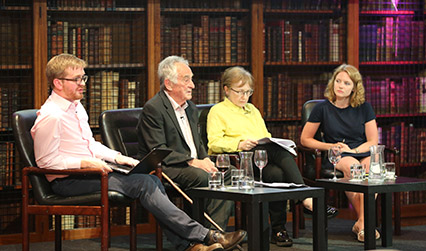On 13 June 2018, Dr Barnabas Calder, Ted Cullinan, and Suzanne Waters came to the RCP to talk about the life, work and personal papers of modernist architect Denys Lasdun.
The archive of a lifetime
17 years after his death in 2001, today Sir Denys Lasdun is students’ and researchers’ most requested architect at the RIBA Library. As part of the London Festival of Architecture, the RCP museum hosted a panel discussion on Lasdun’s legacy, which delved into the British architect’s archive with arguably those who know his work best; the experts who spent hundreds of hours cataloguing his archive and his former colleague, architect Ted Cullinan CBE.
The enormous task of cataloguing a lifetime’s work was given to Dr Barnabas Calder, architectural historian and lecturer, and Suzanne Waters, art and architectural historian at RIBA library, who divided the content between them at the mid-point of Lasdun’s career in the early 70s.

Calder took us back to the beginning of the archive, where a young Lasdun built his first house as a second year architecture student at the Architectural Association (AA). So fervent was his ambition, he agreed to the commission without considering at what point his knowledge might fall short. Decades later, Lasdun recalled that he’d had to ask advice from a third year student about drainage systems as he hadn’t reached that part of the course by then.
Ted Cullinan is a former Lasdun student who went on to be a RIBA gold medal award-winning architect. He told a raptured audience how incredibly informative Lasdun was as a tutor and what a thrill it was to be taught by a practising architect. Later, after graduating from Berkeley in California, Cullinan worked for Lasdun over two periods, most notably on the University of East Anglia (UEA) student residences. He spoke of him fondly as ‘determined and passionate’ but also of the office hierarchy that sometimes made it a difficult place to work: ‘He was the most charming person on earth, but he could also be horrible, like all great men.’

Suzanne Waters, the third speaker of the evening – and coincidentally a UEA alumna – has an intimate knowledge of the latter half of the archive, having spent four years cataloguing Lasdun’s work of the early 1970s to the 1990s. Waters spoke with familiarity of the other members of the creative Lasdun clan: his widow Susan, a designer and writer, and children all of whom continue to work in the arts, Louisa as a composer, James as a writer, and William as a sculptor.
Modernist lines
At first glance perhaps, Lasdun’s buildings do not look alike, but the more images the speakers presented from the archive, the more subtle similarities became visible; full-height glazing bringing the outside in, staggered foyers, sunken ceiling patterns known as ‘coffering’, and buildings laid out in cross sections with an acute awareness of how they sit within the landscape, whether urban or rural.
The RCP commission in Regent’s Park was a watershed for Lasdun, says Cullinan. Having previously built local authority buildings in the post-war years, here was a historical institution with core traditions and strong sense of identity, and thanks to the Wolfson Foundation, the budget to use high quality materials.
Ladsun loved tradition and the ceremonies of the RCP, he showed that modern architecture could rise to the occasion … I think that’s the greatness of this building. Ted Cullinan

The panel were asked how Lasdun managed the relationship with the client and how he achieved so many successes in creating uncompromisingly modern buildings, despite common public criticism. Dr Barnabas Calder explained Lasdun’s long briefing process with the client for each of his commissions. With the RCP this took months, with the National Theatre this took years. Lasdun extracted everything he could get from the client about what they thought their building was for, what they thought their institution was about. He went along to their events, he watched them in day to day action, and he made masses of notes. Once he had a feeling of what the soul of the organisation was he locked himself away in a room with his team to design the building, which once finalised was not to be negotiated with.
When Susan Lasdun passed away in 2017, after a phone call from the family, Barnabas and Suzanne were invited to go to the Lasdun home to start to collate his remaining archive. Suzanne remembered this as an emotional moment: ‘Susan kept everything, letters, postcards, photographs, envelopes of photographs labelled ‘keep but do not publish’, always with the intention for it to be a public resource.’

Calder described the archive as an exceptional view of an architect’s practice containing very complete records of conversations he had in order to defend decisions being made between him and the client. His day to day interactions include the positive reactions to meeting clients and his excitement at a new project. The disappointing areas, Calder notes, are the early stage models that haven’t survived, but that the archive is rich in public and press interactions as well as with clients, giving us valuable insights into Lasdun’s approaches and ways of working.
My love for Lasdun sprung from three deep wells – as a man, a family man, and a social being. I loved his difficult self, his hard-won work and serious defender of the faith, I loved his great achievement. He will live forever for all these reasons. Ted Cullinan, Architects Journal, 2001
‘Spotlight on modernist architecture: Denys Lasdun’s legacy’ with Dr Barnabas Calder, Ted Cullinan, and Suzanne Waters, chaired by Natalie Craven, 13 June 2018.
Natalie Craven, public programmes officer
The Lasdun archive is held at the RIBA library at the V&A and the photographs are held at RIBA, 66 Portland Place and publically available to view by appointment.
